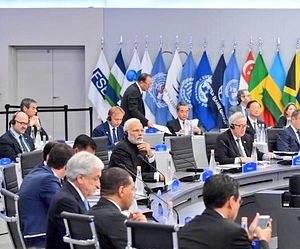At the G-20 summit in Buenos Aires, Argentina, Indian Prime Minister Narendra Modi’s outreach to various world leaders signaled how pragmatism has become a key driver of Indian foreign policy behavior. India’s economic rise and its ability to manage diverse and at times even contradictory global relationships has given New Delhi newfound leverage in its diplomatic engagements. And Modi is not diffident in using that leverage.
On the one hand, this resulted in a Modi’s outreach to Saudi Arabia in Argentina, when he decided to ignore global opprobrium directed at Saudi Crown Prince Mohammed bin Salman (MBS) and met him at his residence. The result was Saudi Arabia’s offer to supply oil and petroleum products to meet New Delhi’s growing energy demands at a time of great volatility in the oil market. Riyadh is facing a backlash in the Western world over the gruesome murder of Washington Post journalist Jamal Khashoggi, with the role of MBS personally under close scrutiny. For MBS, some kind of global accommodation is high on agenda and Modi tried to make the best use of that space.
At a broader level, New Delhi managed to pull off two seemingly contradictory trilaterals. Modi met with United States President Donald Trump and Japanese Prime Minister Shinzo Abe to underscore India’s firm commitment to make the Indo-Pacific a region for shared economic growth, prosperity, and security. Asserting that India will “continue to work together on shared values,” Modi said, “When you look at the acronym of our three countries — Japan, America, and India — it is ‘JAI’, which stands for success in Hindi.” Abe hoped that the trilateral would reinforce the trilateral partnership and its close cooperation “towards realizing a free and open Indo-Pacific.” Trump also acknowledged that “the relationships between our three countries is extremely good and extremely strong… with India, maybe stronger than ever… We are doing very well together. We are doing a lot of trade together. We are doing a lot of defense together, a lot of military purchases.” The three nations shared their views on progressing a free, open, conclusive and rule-based order in the Indo-Pacific region, based on respect for international law and peaceful resolution of all differences.
The Indo-Pacific construct is now at the center of strategic jockeying in the region and the three nations have been trying to define the exact scope of their engagement. Modi had explained India’s stand on the strategic Indo-Pacific region in his keynote address at the Shangri-La Dialogue in Singapore in June. “India does not see the Indo-Pacific Region as a strategy or as a club of limited members. Nor as a grouping that seeks to dominate. And by no means do we consider it as directed against any country. A geographical definition, as such, cannot be,” he had said. But China’s rapid rise and the challenge it is posing to geopolitical stability is at the heart of the evolution of the Indo-Pacific and the trilateral in Argentina reinforced the desire of the three states to take it forward.
Hours after the “JAI” trilateral, Modi joined Chinese president Xi Jinping and Russian President Vladimir Putin for another trilateral – the “RIC” – the second among the three countries after a gap of 12 years. The underlying rationale for this trilateral was quite different, as the three nations discussed enhancing mutual cooperation in international forums. According to the Indian Ministry of External Affairs, “they agreed on the importance of reform and strengthening of multilateral institutions that had benefited the world, including the United Nations, WTO and well-established as well as new global financial institutions. They underscored the benefits of a multilateral trading system and an open world economy for global growth and prosperity.”
While China is the one driving JAI, it is the Trump administration’s challenge to the global economic order that is largely behind India’s outreach to China and Russia. The fact that New Delhi managed to pull this off is a tribute to Modi’s astute investment in managing major power relations over the last few years. This is a period of fluid partnerships and Indian diplomacy will have to be nimble if Indian interests are to be preserved. Modi’s engagements at the G-20 underline that New Delhi is capable of managing this fluidity.
































